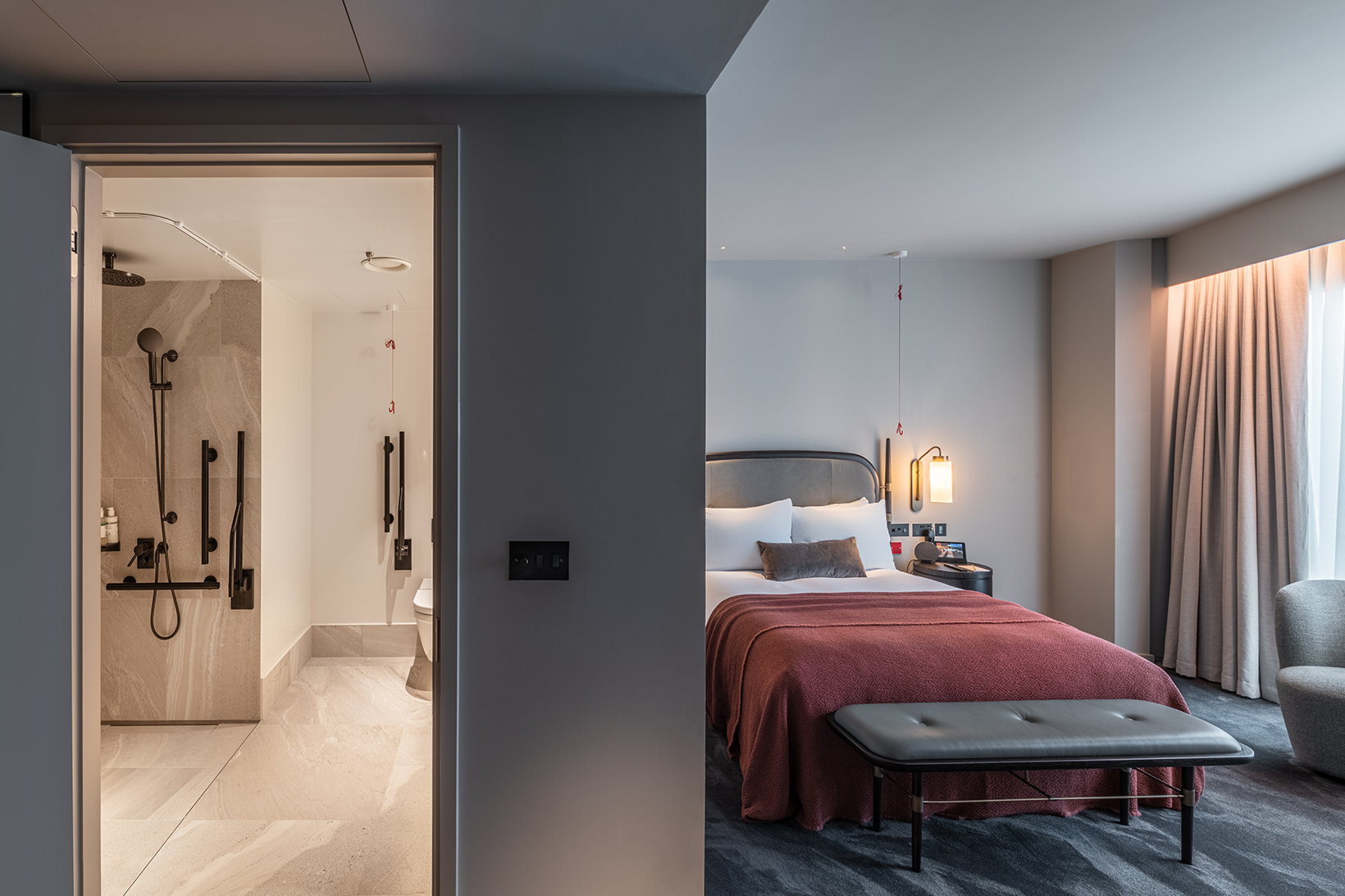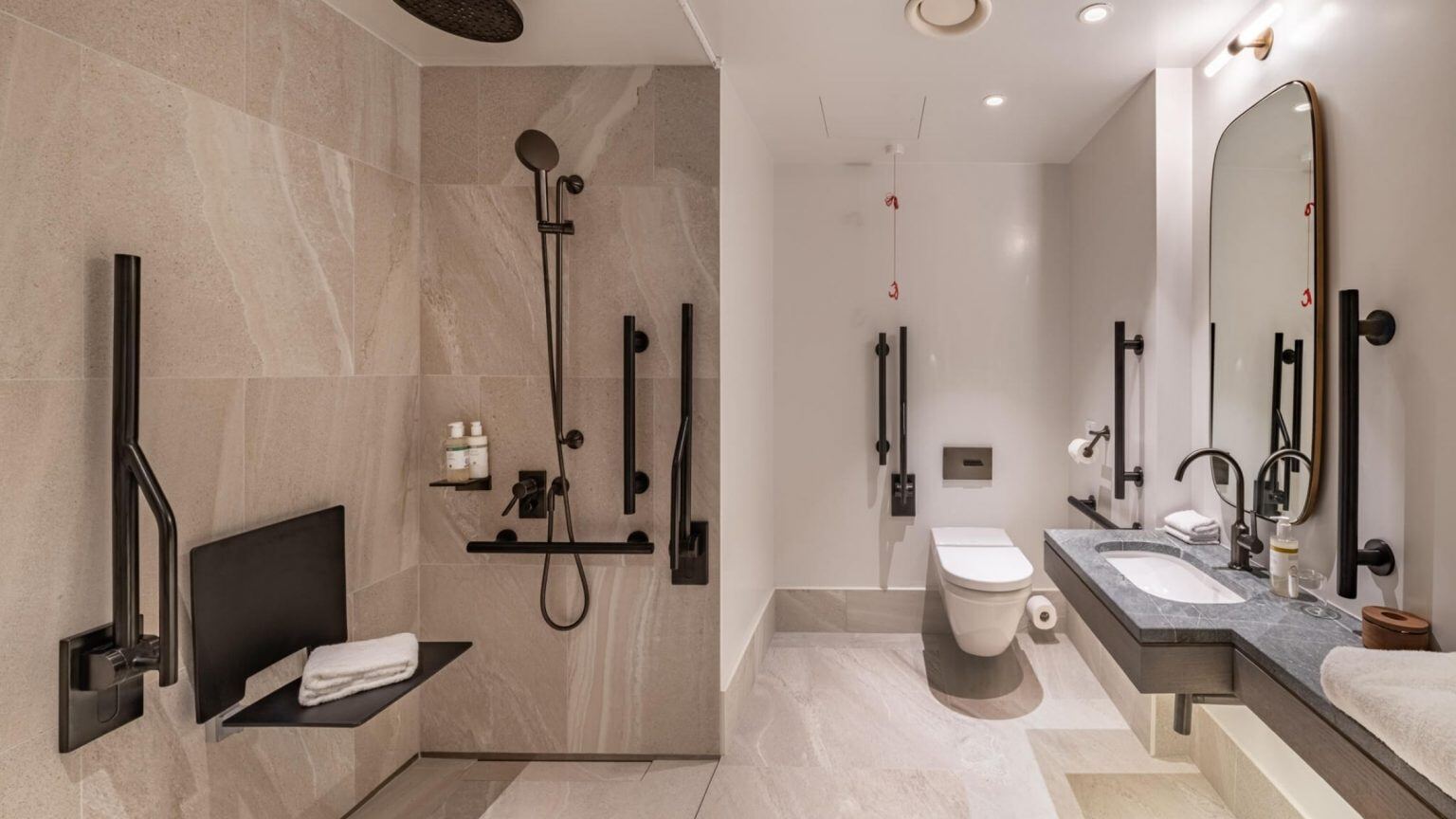Doc M: Glossary of Terms
Access Statement
A document that describes how a building or environment has been designed to provide access for all users, including those with disabilities.
Accessibility
The ease with which people with disabilities, including those who use wheelchairs or have other mobility impairments, can approach, enter, and use a building.
Ambulant Disabled
Someone with a disability that does not require the use of a wheelchair and can walk with or without assistance.
Alarm Cord / Pull Cord
A red cord with triangular grips that hangs from the ceiling to one side of a disabled toilet. The cord is designed to be pulled by a user who requires assistance, for example, if they have slipped and fallen to the floor while transferring from a wheelchair to the toilet seat.
Anti-vandal
Fixtures designed specifically to prevent vandals from gaining purchase to remove them or made from materials that resist graffiti and other methods of defacement.
Anti-ligature
Fixtures designed to prevent accidental or intentional self-harm by making it impossible to attach a ligature (anything that can be used to tie or bind, like a cord).
Back to Wall
A toilet pan and/or cistern that is designed to sit flush against the wall, with all plumbing concealed inside the sanitaryware itself.
BS8300
BS8300 is a standard developed by the British Standards Institution (BSI) that states how a building should be designed, constructed, and maintained to create an accessible and inclusive environment for people with disabilities.
Changing Places Toilet
A specialised toilet that provides facilities for children and adults with severe disabilities who require the support of one or more carers for toileting. Changing Places toilets are equipped with a hoist, a shower, and an adult-sized changing bench, as well as additional space.
Close Coupled Toilet
A toilet that has the cistern closely connected to or directly mounted on the back of the toilet pan.
Concealed Shower Valve
A shower valve designed to be recessed into the wall and concealed behind a decorative finish, e.g., tiles. Only the shower controls are visible on the outside.
Doc M
Approved Document M (often referred to as Doc M) is a guidance document that accompanies Part M of the Building Regulations in the UK. Approved Doc M provides practical guidance and sets out specific requirements for achieving compliance with the accessibility standards outlined in Part M.
Doc M Pack
A pack containing a range of elements required to create a Doc M compliant toilet, shower, or changing facility. Doc M Packs typically contain a combination of sanitaryware, grab rails, taps/shower fittings, and support aids including shower seats and/or backrests.
"Doc M Packs typically contain a combination of sanitaryware, grab rails, taps/shower fittings, and support aids including shower seats and/or backrests."
Disability Discrimination Act
The Disability Discrimination Act (1995) made it unlawful to discriminate against people with a disability in connection with employment or the provision of goods, services, and facilities. It placed a responsibility on employers and business owners to make reasonable adjustments to level the playing field for disabled people. The DDA was replaced by the Equality Act (2010) but is still sometimes referred to today.
Equality Act
The Equality Act (2010) is legislation that protects people from discrimination based on age, ability, race, sexuality, and other factors. In relation to Doc M, the Equality Act demands that employers, building operators, and service providers make 'reasonable adjustments' to ensure that disabled people can safely and comfortably approach, enter, and use a building or service.
Exposed Shower Valve
A shower valve that is mounted on the wall rather than concealed within the wall. Exposed shower valves typically have the shower controls mounted on the top or front of the valve.
Fixed Grab Rail
A grab rail that is fixed to the wall at both ends and not designed to lift up, fold, or be removed.
Friction Lift
A simple mechanism for raising and lowering a hinged grab rail. Friction pads ensure the rail won’t fall down suddenly when it’s in the raised position (see also lift and lock).
Grab Bars
Another name for grab rails – fixed bars attached to the wall and designed to provide support for wheelchair users when transferring on and off the toilet pan, or for ambulant disabled users when moving around the bathroom or toilet cubicle.
Hinged Grab Rail
A grab rail that is fixed to the wall at one end by means of a hinged bracket. This allows the rail to be folded up against the wall and then folded back down again. Typically used on the wheelchair side of the toilet, a hinged grab rail allows the user to bring their chair parallel to the toilet pan, transfer across, and then fold the rail down for additional support when seated.
"A hinged grab rail allows the user to bring their chair parallel to the toilet pan, transfer across, and then fold the rail down for additional support when seated."
Inclusive Design
The practice of designing buildings and interiors with a diverse range of users in mind. Inclusive design means considering things like gender, physical disability, neurodivergence, or age, and making it as simple and enjoyable as possible for everyone to use the same space.
Light Reflectance Value
Light Reflection Value is the total quantity of visible light reflected by a surface at all wavelengths and directions when illuminated by a light source. It is used in architecture and interior design to determine how much light a surface reflects or absorbs. It is used to assist with determining visual contrast, making sure that people with a visual impairment can easily see the difference between floors and walls, and locate things like grab rails.
Low Level Toilet
A low-level toilet is not ‘lower’ than a normal toilet. Rather it refers to the fact that the pan is lower down than the cistern, which is wall-mounted. This allows for easy cleaning and also the installation of a backrest on the wall beneath the cistern, for additional user support. Like all Doc M compliant toilets, the standard seat height for a low-level toilet is 480mm.
Lift and Lock Rail
A folding grab rail with a locking mechanism that allows it to be fixed in either a fully upright or fully lowered position.
Projection
The distance (usually in mm) that a toilet pan, basin, or other fixture projects from the wall into the room. Projection is based on standard wheelchair dimensions – for example, a toilet pan must project 750mm because that enables the user to bring their wheelchair alongside and transfer horizontally across, minimizing the risk of falls. Basins must project enough to allow the user's knees to go underneath while seated – but not so much that they block the turning circle or doorway.
Packer Box
A ‘filler’ installed on the wall behind a shower seat or toilet pan in order to achieve the correct projection, so that the user can perform a seated transfer safely.
PVD
Physical Vapour Deposition (PVD) is a finishing method for metal fixtures. Performed in a vacuum, it permanently bonds particles of solid metals like brass to a stainless steel surface. This process can be used to create decorative finishes on grab rails and other Doc M products, while making sure they remain highly durable.
Thermostatic Mixer
A tap or shower valve designed to mix hot and cold water continuously, even when other outlets are turned on. The maximum temperature is preset to eliminate the risk of burns and scalds.
Transfers (left or right)
Transfers refer to the way a disabled user transfers onto the toilet from their wheelchair. Right-handed users will typically reverse their wheelchair parallel to the left side of the toilet cistern (facing out) and then perform a right-handed transfer. Left-handed users will do the opposite. In facilities with one disabled toilet, a right-handed transfer layout is the standard. Where there is more than one disabled toilet, both options should ideally be offered.
WRAS Approved
The Water Regulations Advisory Scheme (WRAS) is a subscription-based accreditation body that exists to promote and ensure compliance with the Water Supply (Water Fittings Regulations) in England and Wales, and the equivalent byelaws in Scotland and Northern Ireland. The WRAS also offers an approval system, which acts as a way for manufacturers to demonstrate that their products – such as taps, valves, and boilers – comply with the regulations. However, this same approval can also be granted by other bodies.
Wall Hung Toilet
A toilet pan that is mounted on the wall, typically with a concealed cistern. Wall hung toilets have a strong steel framework concealed within the wall to support the weight of the toilet pan and user. Wall-hung toilet pans can be preferable because they make it very easy to keep the floor and the area around the toilet clean.
"Wall-hung toilet pans can be preferable because they make it very easy to keep the floor and the area around the toilet clean."



